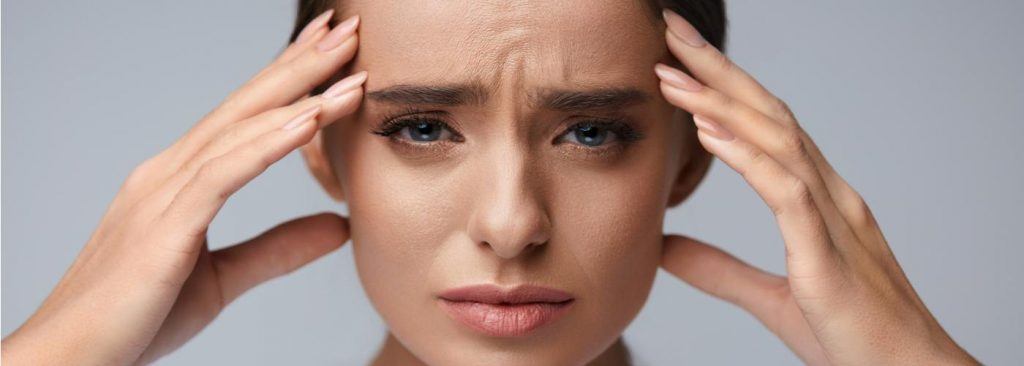Do you suffer from frequent, debilitating migraines? Do you know what treatment options are out there for you? Chronic Migraines are more common than you might think. The Migraine Research Foundation states that almost 40 million Americans suffer migraines¹. If you are one of these 40 million migraine victims, or you are concerned that you may have experienced a migraine, read our list of symptoms and treatment options to learn more about the condition.

Is the head pain that you are experiencing just an intense headache or is it a migraine? Anyone that has intense headaches could in reality have a problem with chronic migraines. To know the difference between the two, we’ve laid out the symptoms below.
Migraine Symptoms
The most significant difference between a headache and a migraine is that a migraine involves intense throbbing pain. Other symptoms might include disturbances in vision and nausea. Some migraine attacks are so severe that people end up bedridden.
Migraine Trust lists four main migraine attack stages. Each stage has specific symptoms:
1. Prodrome Stage
The prodrome stage is the best way to tell if you are about to have a migraine. Lasting up to 24 hours before the migraine hits, the symptoms of the prodrome stage can include mood changes, sweet food cravings, fatigue, thirst, and a stiff neck. If you are experiencing any of these symptoms or feel that a migraine is just about to hit, you should take action to try to avoid the worst of the attack later on.
2. Aura Stage
The Aura stage may only take place in certain circumstances. Usually, the aura comes right before the main attack and can last up to 60 minutes. Neurological symptoms caused by the aura stage include seeing sparkles, dark spots, or colored spots. Dizziness, tingling, numbness, and weakness, along with speech and hearing problems, may occur during this stage.
For someone who has never experienced an aura before, this stage of a migraine can be very frightening. The best thing to do is to stay calm, treat your symptoms as soon as possible, and know that it will soon pass.
3. Attack Stage
This is the main stage of any migraine and involves severe, throbbing, and often unbearable pain on one or both sides at the same time. Forehead pain is also a possibility, but the pain in the back of the head is rare. You may also vomit or be nauseous during this time, and experience light, touch, and sound sensitivity.
The best thing to do during this stage, if possible, is to find somewhere dark and quiet where you can rest as much as possible until the pain passes.
4. Postdrome Stage
The postdrome stage can involve a hangover-like feeling that last hours or days with symptoms similar to the prodrome stage. Give yourself some time to relax and recover as much as you can until you start to feel more like yourself again.
Migraine Medication
There are two types of migraine medications according to the Mayo Clinic: preventive drugs and pain relievers. Pain relievers such as aspirin, ibuprofen, and acetaminophen don’t usually require a prescription but they’re for less severe cases.²
For more severe cases, a doctor might prescribe you triptan medications that constrict blood vessels and interfere with pain pathways. Another class of drugs you might get prescribed are ergots, which are a combo of ergotamine and caffeine. Furthermore, there are opioids which are reserved for extreme cases, and glucocorticoids to boost other pain reliever medications.
If you have frequent migraine attacks lasting 12 or more hours with extended aura stages, you might be a candidate for preventive drugs. This group of medications includes beta-blockers for high blood pressure and anti-seizer prescriptions to reduce the number of attacks. Lastly, quarterly botox injections could also ease symptoms and attacks.
Alternative Migraine Treatment Options
Besides medical approaches, there are many lifestyle changes and non-traditional treatments that might work for you, such as:
-Yoga
-BioFeedBack
-Massage Therapy
-Cognitive Behavioural Therapy
-Acupuncture
Moreover, the American Migraine Foundation recommends avoiding trigger foods like chocolate or alcohol and eating more whole foods, vegetables, and fruits instead of processed food and red meats.³ Quitting smoking and regular exercise is also a must.
There’s a Migraine Treatment Plan for You
To start fighting chronic migraines, make sure to write down your symptoms, triggers, and the length of attacks to help doctors diagnose and treat you. Before booking an appointment, do your research online, compare offers, and book an appointment with a qualified specialist today.
References
[1] “Raising Money for Migraine Research.” Migraine Research Foundation. https://migraineresearchfoundation.org/about-migraine/migraine-facts/
[2] “Migraine.” Mayo Clinic. https://www.mayoclinic.org/diseases-conditions/migraine-headache/diagnosis-treatment/drc-20360207
[3] Rashmi Halker et al. “Migraine and Diet.” American Migraine Foundation, 1 January 2016. https://americanmigrainefoundation.org/resource-library/migraine-and-diet/
